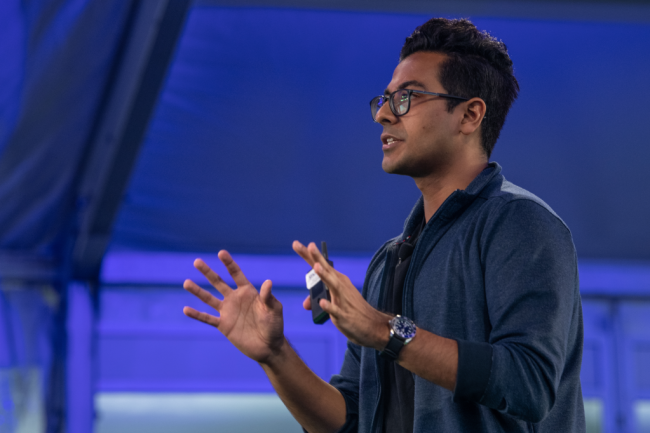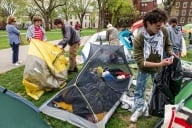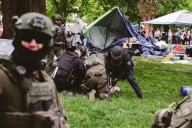You have /5 articles left.
Sign up for a free account or log in.

Manu Meel, CEO of BridgeUSA: today’s college students “have not had a great sample size of democracy.”
The Nantucket Project
NANTUCKET, Mass.—Is there a civil discourse crisis in higher education?
It would be hard to read the pages of this website and think otherwise. Judging from the controversial speakers shouted down on campuses and the sessions canceled at scholarly meetings, the complicated and often combustible mix of academic freedom, free speech and opposition to hate speech has created a landscape seemingly littered with rhetorical land mines. In the larger context of divisiveness and apparent obstinacy in our political system and among the public, hope for a change in the campus climate seems almost quaint.
And yet, “I’m optimistic,” John Tomasi, president of Heterodox Academy, said last weekend during a conversation here on pluralism in higher education. He described the “state of play in higher education” as being “wildly misunderstood,” with many embracing a “battlefield view” (forcing a binary choice between "truth or social justice") that often results in “suffering, anger, cancellations.”
Tomasi prefers a “historical view,” he said, recognizing that colleges and universities are still early in a nascent process of “giving birth to something the world has never seen: a deeply inclusive university that’s fundamentally committed to the pursuit of knowledge. A lot of us are working from the inside to make that happen.”
Tomasi’s was just one of numerous voices in the conversation here, and while he was among the more openly optimistic, he was joined by many people who are, like him, working from “inside” the academy to build capacity and willingness to engage in civil discourse on even the thorniest topics.
The discussion took place within the larger framework of the Nantucket Project, an organization dedicated to “(re)imagining solutions to today’s complex challenges and strengthening a culture of pluralism in America through conversation and storytelling.”
The group holds an annual TED-style gathering on the historic, tony island off the coast of Cape Cod, and this year’s four-day extravaganza focused intently on pluralism and attempts to bridge differences. It featured an eclectic mix of speakers: artists and journalists such as Ken Burns, Judy Woodruff and Juan Williams; the actors Rainn Wilson and Jennifer Lawrence; and politicians such as Andrew Yang and Brad Raffensperger, the Georgia secretary of state, who was constantly approached by people thanking him for “saving the Republic.” Oh, and Michelle Obama spoke, too.
Higher education was in the background of numerous discussions: Arthur Brooks gave a peek inside the happiness course he offers at Harvard Business School, attendees watched excerpts from a documentary about the Bard Prison Initiative and some speakers suggested that colleges and universities share responsibility for some Americans’ current disinclination to accept those they disagree with.
But it was directly addressed only in one 90-minute discussion sponsored by the Arthur Vining Davis Foundations, which may be best known for supporting public television but also provide funds to private nonprofit colleges and universities. The foundations’ sponsorship of the event included invitations for a few dozen of its grantees and some college leaders (and this journalist).
‘Supply and Demand’
Manu Meel, whose BridgeUSA organization aims to create spaces for open discussion at colleges and schools (and who was profiled on Inside Higher Ed when he was a student at the University of California, Berkeley), sought to ground the conversation by framing efforts to promote civil discourse on campus in economic terms. The “supply” of such efforts, he said, was solid, referring to initiatives such as his own, the Constructive Dialogue Institute, Difficult Dialogues and many others. “The ‘product’ is 90 percent there,” he said.
But the “demand” from students is another story, Meel said. Many traditional-age college students don’t have a clear sense of why a democratic society is important—little wonder, given what they’ve experienced in the arc he sketched of their lives: born around Sept. 11, attending middle school during the turmoil around the Great Recession of the late 2010s, witnessing their first major election in 2016, and then enduring 2020’s hot mess of the pandemic, George Floyd’s murder and economic turmoil.
“They have not had a great sample size of democracy,” he said. “They haven’t seen it deliver.”
When one attendee said she would “probably be apathetic, too” if she’d grown up when today’s students did, Providence College’s Nicholas Longo suggested that the crisis stemmed not from apathy but from a sense of “powerlessness.” Dialogue is important, he said, but many young people are more interested in working together to “solve wicked problems.”
Longo, a professor of global studies at the Roman Catholic institution in Rhode Island, is one of the participants involved in what Meel called the “supply” side of the equation: the various institutional programs, national initiatives and individual faculty experiments designed to encourage students to engage in difficult discussions with people they disagree with, push beyond their comfort zones with people from other backgrounds and be willing to consider changing their minds when confronted with differing perspectives.
Longo and Quincy A. Bevely, Providence’s vice president of institutional diversity, collaborate on the Dialogue, Inclusion and Democracy Lab, which runs a Conversation for Change project (funded by the Arthur Vining Davis Foundations) designed to embed dialogue and deliberation in courses and other campus activities and train students to facilitate those discussions.
Davidson College’s Deliberative Citizenship Initiative (motto: “building democracy one conversation at a time”) has strands integrated into the classroom, campus activities and the surrounding community. The program creates small teams of students from different backgrounds who agree to meet regularly to share ideas for addressing societal problems and disagreements.
Students who go through the program, said Graham Bullock, a political scientist who directs its work, “go back to Thanksgiving with a ‘different disposition’” with regard to conversations with family members with differing points of view.
John Jones, who is two years into his presidency at Dickinson College after a long career as a federal judge, said the liberal arts institution finds itself having to “do some deprogramming” of students who’ve been raised in a “road rage” society, where many have developed a “this or that” mentality. Pushing them beyond the binary takes work, he said.
Focus on the Faculty
While many such projects focus on getting students to overcome peer and other disincentives to engage with those who hold countervailing views, the Nantucket conversation was most surprising—and to some extent disturbing—in revealing how hard it can be to get faculty members to participate in this work.
John Rose leads the Civil Discourse Project at Duke University’s Kenan Institute for Ethics, which among other things trains instructors to incorporate civil discourse into their teaching, as Rose himself does in the course How to Think in an Age of Political Polarization.
Trouble is, “there’s a supply shortage of classes,” he said, because of lack of faculty interest. Some are focused on their research and don’t see it as wise to expend the “energy and effort required to teach gen ed or an interdisciplinary course,” Rose said. “They want to get tenure.” (Rose himself isn’t tenured, he noted with a wry smile.)
Others are opposed to the idea of encouraging debate about what they consider to be “settled” political or social questions, or questions they think “should be settled,” Rose said.
And still others fear the “social cost” that might come from telling one’s (mostly liberal) faculty peers that they are teaching topics that might be politically unpopular.
“As more professors do this,” Rose said, “it will become normalized.” (Marjorie Hass, president of the Council of Independent Colleges, suggested one possible source of instructors who might be well-positioned, and incentivized, to teach courses focused on civil discourse. "This could be a great role for the humanities professors whose courses are underenrolled," she said. "We could be retraining those faculty members to lead those conversations.")
Amy Binder, a sociologist at Johns Hopkins University and author of The Channels of Student Activism: How the Left and Right Are Winning (and Losing) in Campus Politics Today (University of Chicago Press, 2022), said she was duly impressed by the numerous well-planned and well-executed programs philanthropists are funding. “But I would hate for funders or really anyone else to think that in the absence of these large coordinated programs, there is nothing else going on on campus,” she said via email. “Day to day in their classes, faculty are helping students engage across political differences. Perhaps not in so many words, but in deed.”
When the pandemic forced Binder to change her qualitative methods course away from ethnography-based research to interviews on Zoom, she decided to have her students collect data on a single topic—they chose student activism, apropos when it comes to her recent book. The research project required each student to conduct three semistructured interviews, and Binder “strongly encouraged” them to talk to student clubs representing “political viewpoints different from their own.”
“If they thought of themselves as leftists, I encouraged them to seek out members of the College Republicans and Turning Point clubs,” she said via email. “We adopted a very capacious definition of ‘politics,’ so I also encouraged them to try to interview students from the Black Student Association, Latinx clubs, religious groups, LGBTQ+ centers.”
Not only did the students learn how, “from the stance of a curious researcher,” to try to understand another person’s worldview, in ways that were “analytical, not judgmental or argumentative,” but the 60-odd interviews formed the basis of a diverse sample through which they learned about coding interviews, she said.
The final assignment: a “journal length paper on a subject of their choice, using whichever coded excerpts they wished to, but drawing on no fewer than 10-15 transcripts,” Binder said. “They produced very fine papers—I was impressed.”









